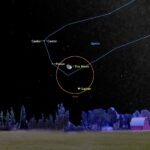Now Reading: A Deep Search For Exomoons Around WISE 0855 With JWST
-
01
A Deep Search For Exomoons Around WISE 0855 With JWST
A Deep Search For Exomoons Around WISE 0855 With JWST


The time-series spectra with the full wavelength range (in microns) of the observations shown on the x-axis, observation time (in hours) on the y-axis, and a color bar representing the amplitude variability for any given flux value as a percent deviation from the mean. The 2 wavelength regions used to construct the light curves are shown where each has a distinct variability pattern. Region 1: negative, positive, negative positive amplitude; Region 2: negative, positive amplitude. The picket fence pattern (narrow striping) visible in region 2 is due to CO absorption. — astro-ph.SR
JWST is collecting time-series observations of many free-floating planets (FFPs) to study their weather, but these light curves are the ideal datasets to search for exomoons that transit the FFP during observations.
In this paper, we present observations of the planetary-mass Y dwarf (T=250−285K, M=6.5±3.5MJup, d = 2.3pc) WISE J085510.83-071442.5 (WISE 0855), whose proximity and brightness make it ideal for a transiting exomoon search. We examine 11 hours of time-series spectra from the JWST Near-Infrared Spectrograph (NIRSpec) whose sensitivity, in combination with Gaussian process (GP) modeling, allows for the disentanglement of exomoon transits from WISE 0855’s variability.
We do not find statistically significant evidence of an exomoon transit in this dataset. Using injection and recovery tests of artificial transits for depths ranging between 0.1-1% (0.35-1.12 R⊕) we explore the exomoon parameter space where we could successfully detect transits. For transit depths ≥0.5% (1.96RTitan), our detection rate is 96%, which, for WISE 0855, corresponds to a moon with a companion-to-host mass ratio similar to that of Titan and Saturn.
Given our sensitivity, transit probabilities, and our observational duration, we determine a ∼91% probability of detecting a Titan mass analog exomoon after 18 such observations if every observed system hosts a Titan mass analog exomoon in a Galilean-like system. This suggests that JWST observations of dozens of FFPs could yield meaningful constraints on the occurrence rate of exomoons. This paper is the first demonstration that JWST is sensitive to Galilean moon mass analogs around FFPs.
Mikayla J. Wilson, Mary Anne Limbach, Andrew J. Skemer, Johanna M. Vos, Brittany E. Miles, Melanie J. Rowland, Andrew Vanderburg, Adam C. Schneider, Caroline Morley, Brooke Kotten, Andrew Householder, Roxana Lupu, James Mang, Richard Freedman
Comments: 19 pages, 18 figures, accepted for publication in AJ
Subjects: Earth and Planetary Astrophysics (astro-ph.EP); Instrumentation and Methods for Astrophysics (astro-ph.IM); Solar and Stellar Astrophysics (astro-ph.SR)
Cite as: arXiv:2510.24575 [astro-ph.EP] (or arXiv:2510.24575v1 [astro-ph.EP] for this version)
https://doi.org/10.48550/arXiv.2510.24575
Focus to learn more
Submission history
From: Mikayla Wilson
[v1] Tue, 28 Oct 2025 16:10:15 UTC (14,777 KB)
https://arxiv.org/abs/2510.24575
Astrobiology,
Stay Informed With the Latest & Most Important News
Previous Post
Next Post
-
 012024 in Review: Highlights from NASA in Silicon Valley
012024 in Review: Highlights from NASA in Silicon Valley -
 02Panasonic Leica Summilux DG 15mm f/1.7 ASPH review
02Panasonic Leica Summilux DG 15mm f/1.7 ASPH review -
 03How New NASA, India Earth Satellite NISAR Will See Earth
03How New NASA, India Earth Satellite NISAR Will See Earth -
 04And Thus Begins A New Year For Life On Earth
04And Thus Begins A New Year For Life On Earth -
 05Astronomy Activation Ambassadors: A New Era
05Astronomy Activation Ambassadors: A New Era -
06SpaceX launch surge helps set new global launch record in 2024
-
 07Space Force plans new ‘Futures Command’ amid pressure to speed up modernization
07Space Force plans new ‘Futures Command’ amid pressure to speed up modernization




















